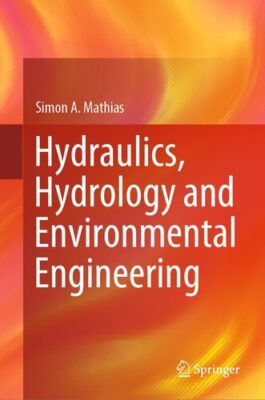Hydraulics, Hydrology and Environmental Engineering
Pdf Book Name: Hydraulics, Hydrology and Environmental Engineering
Author: Simon A. Mathias
Publisher: Springer International Publishing
ISBN-10, 13: 9783031419737,9783031419720
Year: 2024
Pages: 769 Pages
Language: English
File size: 99 MB
File format: PDF,EPUB

Hydraulics, Hydrology and Environmental Engineering
Books Details:
These three disciplines are closely intertwined, often working together to address critical challenges related to water resources management, environmental protection, and infrastructure development. Let’s delve into each field:
Hydraulics
Definition: The science and technology of fluid flow and fluid power.
Key Concepts:
Fluid properties (density, viscosity, compressibility)
Fluid statics (pressure distribution, buoyancy)
Fluid dynamics (flow patterns, energy equations, Bernoulli’s principle)
Open-channel flow (rivers, canals)
Pipe flow (water supply, drainage systems)
Applications:
Design of water distribution systems
Analysis of hydraulic structures (dams, weirs, spillways)
Flood control and management
Hydropower generation
Irrigation systems
Hydrology
Definition: The scientific study of the movement, distribution, and quality of water on Earth and other planets, including the water cycle, water resources, and environmental watershed sustainability.
Key Concepts:
Precipitation (rain, snow, hail)
Infiltration and runoff
Surface water hydrology (streamflow, flood frequency analysis)
Groundwater hydrology (aquifer properties, well hydraulics)
Water quality (chemical, biological, physical parameters)
Applications:
Water resource management
Flood forecasting and warning
Watershed management
Groundwater contamination assessment and remediation
Water supply planning
Environmental Engineering
Definition: The application of scientific and engineering principles to protect human health and the environment.
Key Concepts:
Water treatment and wastewater treatment
Air pollution control
Solid waste management
Environmental impact assessment
Sustainable development
Applications:
Design and operation of wastewater treatment plants
Development of air quality standards and control strategies
Management of hazardous waste
Restoration of contaminated sites
Climate change mitigation and adaptation
The Interplay
These three fields often work together to address complex environmental challenges. For instance:
Flood Control: Hydraulic engineers design flood control structures, while hydrologists predict flood events and assess their impacts.
Water Supply: Civil engineers design water distribution systems, while hydrologists assess water availability and quality.
Water Quality: Environmental engineers treat wastewater and monitor water quality, while hydrologists study the movement of pollutants in water bodies.
By understanding the fundamental principles of hydraulics, hydrology, and environmental engineering, engineers can develop innovative solutions to address pressing environmental issues and ensure a sustainable future.
DMCA Disclaimer: This site complies with DMCA Digital Copyright Laws. Please bear in mind that we do not own copyrights to these books. We’re sharing this material with our audience ONLY for educational purpose. We highly encourage our visitors to purchase original books from the respected publishers. If someone with copyrights wants us to remove this content, please contact us immediately. All books on the edubookpdf.com are free and NOT HOSTED ON OUR WEBSITE. If you feel that we have violated your copyrights, then please contact us immediately (click here).



